LAKE TRUMMEN
A view from lakeside hill near Teleborgs Slott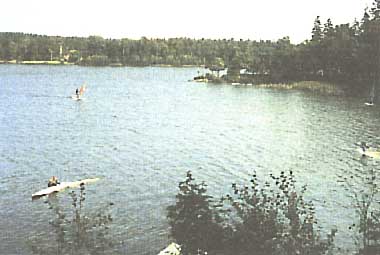
Photo: A. Kurata
A. LOCATION
- Kronoberg, Sweden.
- 56:52N, 14:50E; 161.2 m above sea level.
B. DESCRIPTION
-
The small lake Trummen is in the city of Vaxjo in the south Swedish upland. The lake was oligotrophic till the beginning of this century, but the increase of population, domestic sewage and industrial waste water resulted in progressive eutrophication. The intense bloom of blue-green algae was observed annually in the lake. Expanding growth of reeds and killing of fish due to oxygen deficiency proceeded. In 1958 municipal sewerage and industrial waste water were diverted, but without expected effects. A restoration research project was thereafter planned by scientists from the Institute of Limnology of Lund University in cooperation with the Vaxjo authorities.
Suction dredging, the main part of the restoration project, was carried out in 1970-1971. Approximately 60 cm of FeS-rich black and brown mud was removed from the lake bottom and transferred to specially prepared depositing ponds through pipelines. The depositing ponds covered a total area of 18.5 ha with surrounding embankments about 4.8 km in total length. The total cost, including for preliminary survey, dredging, embankment and other treatments, amounted to 2,575,000 Sw. Kr.
The Trummen project drew world-wide attention, being the first successful example of large-scale restoration of a lake where sediment pumping was employed. The lake is being visited by many administrators and scientists from various parts of the world who are interested in the study of this excellent achievement in applied limnology.
C. PHYSICAL DIMENSIONS
| Surface area [km2] | 1 |
| Volume [km3] | 0.00126 |
| Maximum depth [m] | 2.5 |
| Mean depth [m] | 1.6 |
| Water level | Regulated |
| Length of shoreline [km] | 6.6 |
| Residence time [yr] | 0.4 |
| Catchment area [km2] | 13 |
D. PHYSIOGRAPHIC FEATURES
D1 GEOGRAPHICAL- Bathymetric map: Fig. EUR-12-01.
- Names of main islands: Arno.
- Number of outflowing rivers and channels (name): 1 (Vallebacken R.).
- Climatic data at Kalmar, 1931-1960 (3)
| Mean temp. [deg C] | ||||||||||||
| Jan | Feb | Mar | Apr | May | Jun | Jul | Aug | Sep | Oct | Nov | Dec | Ann. |
|---|---|---|---|---|---|---|---|---|---|---|---|---|
| -1.4 | -1.6 | 0.2 | 4.7 | 9.5 | 14.5 | 17.4 | 16.7 | 13.2 | 8.6 | 4.3 | 1.4 | 7.3 |
| Precipitation [mm] | ||||||||||||
| 37 | 27 | 25 | 28 | 36 | 36 | 56 | 55 | 47 | 43 | 43 | 38 | 471 |
- Number of hours of bright sunshine (Kalmar, 1931-1960): 1,833 hr yr-1.
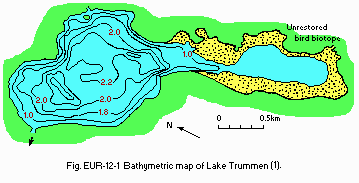
Bathymetric map (1).
- Water temperature [deg C]
| Jul*1 | Feb*2 | Ann. |
|---|---|---|
| 16 | 2 | 6.2 |
| *1 Mean of the warmest month. | ||
| *2 Mean of the coldest month. | ||
- Freezing period: December-March (120 days).
- Notes on water mixing and thermocline formation
- The thermocline is not formed.
E. LAKE WATER QUALITY
E1 TRANSPARENCY [m]-
1970-1976; 0.35-0.85 (4).
1987; 0.3 (Q).
| 1972 | ||||
| Depth [m] | Winter | Spring | Summer | Autumn |
|---|---|---|---|---|
| S* | 5.6 | 5.4 | 6.7 | 6.5 |
| * Surface. | ||||
| 1987 (Q) | ||||
| Depth [m] | Ann. | |||
| 0.5 | 7.5 | |||
| 1972 | ||||
| Depth [m] | Winter | Spring | Summer | Autumn |
|---|---|---|---|---|
| S* | 10.5 | 8.0 | 8.0 | 11.5 |
| * Surface. | ||||
-
Determined by KMnO4 method.
1987
0.5 m: 17.5.
| 1972 | ||||||||||||
| Depth [m] | Jan | Feb | Mar | Apr | May | Jun | Jul | Aug | Sep | Oct | Nov | Dec |
|---|---|---|---|---|---|---|---|---|---|---|---|---|
| S* | - | - | - | 113 | 68 | 43 | 51 | 106 | 58 | 14 | 21 | - |
| * Surface. | ||||||||||||
-
1987 (Q)
0.5 m: 91.
- Total-N [mg l-1]
| 1972 (4) | ||||
| Depth [m] | Winter | Spring | Summer | Autumn |
|---|---|---|---|---|
| - | 0.87 | 0.50 | 0.76 | 0.54 |
-
1987 (Q)
0.5 m: 1.73.
- Total-P [mg l-1]
| 1972 (4) | ||||
| Depth [m] | Winter | Spring | Summer | Autumn |
|---|---|---|---|---|
| - | 0.11 | 0.09 | 0.16 | 0.09 |
-
1987 (Q)
0.5 m: 0.106.
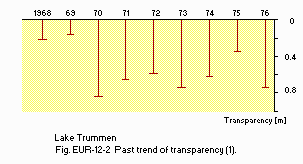
Past trend of transparency (1)
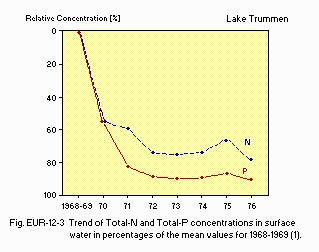
Trend of Total-N and Total-P concentrations in surface water in percentages of the mean values for 1968-1969 (1).
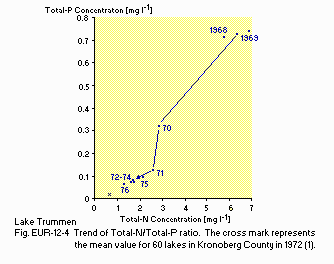
Trend of Total-N/Total-P ratio.
F. BIOLOGICAL FEATURES
F1 FLORA- Emerged macrophytes (1)
Phragmites communis, Typha latifolia, Juncus bulbosus. - Submerged macrophytes (1)
Potamogeton obtusifolius, Utricularia sp., Nitella sp. - Phytoplankton (2)
Aphanizomenon gracile, Aphanocapsa delicatissima, Oscillatoria limnetica var. acicularis, Pediastrum biradiatum, P. angulosum, Staurodesmus spp., Closterium spp., Teilingia granulata, Dinobryon cylindricum, Mallomonas acarioides striatula, Melosira spp., Asterionella formosa, Cyclotella spp., Rhizosolenia longiseta.
- Zooplankton (2)
Anuraeopsis fissa, Filinia longiseta, Trichocerca Pusilla, Chydorus sphaericus, Bosmina longirostris, Keratella cochlearis, K. quadrata. - Benthos
Oligochaeta, Chironomidae, Hirudinea, Ephemeroptera, Anodonta cygnea, Esox lucius, Perca fluviatilis, Rutilus rutilus, Abramis brama, Blicca bjoerkna (1).
| 1972 | |||||
| Apr | May | Jun | Jul | Aug | Sep |
|---|---|---|---|---|---|
| 512 | 880 | 870 | 1,911 | 2,035 | 1,247 |
- Phytoplankton [mg (fresh wt.) l-1]
| 1969 | |||||||||||
| Jan | Feb | Mar | Apr | May | Jun | Jul | Aug | Sep | Oct | Nov | Dec |
|---|---|---|---|---|---|---|---|---|---|---|---|
| 1.3 | 0.6 | 0.8 | 6.8 | 10.2 | 90.4 | 29.1 | 29.0 | 49.9 | 16.9 | 10.7 | - |
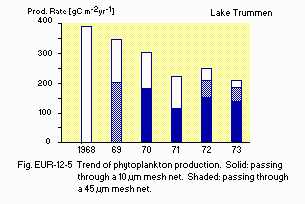
Trend of phytoplankton production.
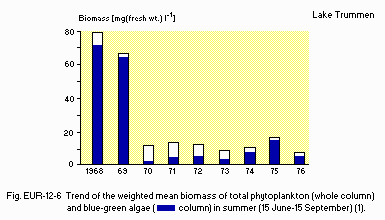
Trend of the weighted mean biomass of total phytoplankton and blue-green algae in summer (15 June-15 September)(1).
F7 NOTES ON THE REMARKABLE CHANGES OF BIOTA IN THE LAKE IN RECENT YEARS (1, 2, 5)
- There was a drastic decrease in phytoplankton biomass from the start of restoration in 1970 and onwards.
- Before the restoration, blue-green algae were most important in the lake's planktonic community, dominating during summer and forming very dense bloom. In 1970, however, their biomass was reduced to 5% of the prerestoration value.
- Improved light conditions have created a colonization of such submerged plants previously not found in the lake as Potamogeton obtusifolius and Nitella. The mussel, Anodonta cygnea, has returned after many years' disappearance.
G. SOCIO-ECONOMIC CONDITIONS
G3 POPULATION IN THE CATCHMENT AREA (Q)| Population | Population density [km-2] | Major cities (population) | |
|---|---|---|---|
| Total | 53,000 | 4,077 | Vaxjo (53,000) |
H. LAKE UTILIZATION
H1 LAKE UTILIZATION-
Fisheries, tourism and recreation (swimming, sport-fishing, yachting), bird-watching.
I. DETERIORATION OF LAKE ENVIRONMENTS AND HAZARDS
I1 ENHANCED SILTATION- Extent of damage: None.
- Present status: None.
- Nuisance caused by eutrophication
Unusual algal bloom (Anabaena, Microcystis) in 1940-1970. Foul smell of tap water in 1940-1970. Harms on fish in 1940-1970.
J. WASTEWATER TREATMENTS
J1 GENERATION OF POLLUTANTS IN THE CATCHMENT AREA-
c) Limited pollution with wastewater treatment.
K. IMPROVEMENT WORKS IN THE LAKE
K1 RESTORATION-
A 0.6 m thick layer of bottom sediment rich in FeS was removed by suction
dredging in 1970-1971.
-
The sewage effluent into the lake was diverted in 1957-1958, but was not
effective to inhibit plankton blooms.
-
As the result of the dredging and removal of the main part of macrophyte
vegetation, the lake ecosystem changed drastically. Concentrations of P and N
were reduced by 90% and 70%, and phytoplankton biomass by 85-90%.
N. SOURCES OF DATA
- Questionnaire filled by Anna Tolstoy, Laboratoriet for miljokontroll, Statens Naturvardsverk, Sweden.
- Lansstyrelsen i Kronobergs Lan & Vaxjo Kommun (ed.)(1977) Sjon Trummen i Vaxjo; Forstord-Restaurerad-Panyttfodd. 32 pp. Vaxjo.
- Cronberg, G. (1982) Phytoplankton Changes in Lake Trummen Induced by Restoration. Folia Limnologica 18. 199 pp.
- Muller, M. J. (1982) Selected Climatic Data for a Global Set of Standard Stations for Vegetation Science. 306 pp. Dr. W. Junk Publishers, The Hague.
- The Lake Restoration Research Group, University of Lund (ed.)(1973) Lake Trummen (Sweden). Mimeographed. 37 pp.
- Cronberg, G., Gelin, C. & Larsson, K. (1975) Lake Trummen restoration project. II. Bacteria, phytoplankton and phytoplankton productivity. Verh. Intern. Verein. Limnol., 19: 1088-1096.


